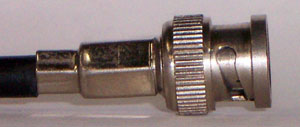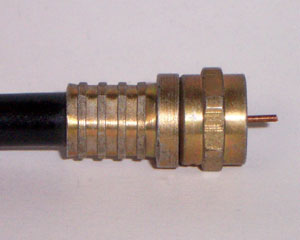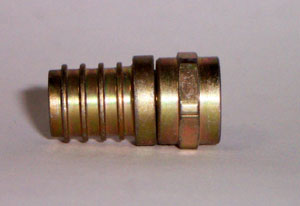THE “F” CONNECTOR AND THE FUTURE OF SDI-CCTV
THE “F” CONNECTOR AND THE FUTURE OF SDI-CCTV
By: Don McClatchie


What is it that the (CATV) Cable TV Industry knows about connectors that the (CCTV)HD-SDI Industry needs to discover? The answer is the low cost, water tight, easy to install, connector used in the CATV industry. The CATV industry uses the “F” type of connector by the hundreds of millions. This connector is in your home, it’s the one used on the back of your TV set and cable box. It is a thread on connector that uses the center conductor wire of the coaxial cable as the center pin for the connection. The connector currently in use by the HD-SDI CCTV industry is the BNC connector. Both of these connectors will work quite well in any installation.
Let’s compare the BNC connector with the F connector. The BNC connector was developed as a quick twist on twist off connector. It was adopted for use on video patch panels where it was necessary to change connections often, and with great speed. In fact the BNC connector’s main feature is its ability to be disconnected quickly. If you push the BNC connector in with a quarter turn then pull it out it is disconnected, a repeat of this motion in reverse will reattach the connector. This makes it easy to disconnect the video cable, but in a security system, is that a good thing for security?
Unlike the F connector the BNC connector has no built-in provision for securing the cable to a camera out in the field. In fact the BNC connector could be disconnected from the camera by a 3 year old child if they could reach the back of the camera. Anybody just fiddling around could reach up and give it a twist, disabling the camera system with a slight momentary press of their fingers.
Security is not the only problem with the BNC connector; it is also quite complex in its manufacture. The BNC connector is made up of as many as 9 different parts and is quite expensive to purchase, its price can range up to several dollars each while the F connector can be had for as little as 20 cents each. This difference in the price of connectors can add up particularly on big jobs with lots of cameras.
Take a BNC completely apart and look at it, you will see the intricate machining and the shear number of parts necessary to manufacture the connector, you pay for this complexity when you buy a BNC connector whose main feature “quick disconnect” is not used in your application.

The normal CCTV coaxial cable is connected at the time of installation and then never removed for the life of the system. So why should the industry use an expensive “quick disconnect” BNC connector? BNC connectors have another hidden cost, the labor cost of attaching the connector to the cable.
To attach a coaxial cable to the BNC connector, the installer must trim the center conductor and insulation to vary precise lengths and then trim the outer insulation and braided shield to an accurate length. The trimming of the cable is the most critical part of the installation and it is not easy to get it right. Then the center pin of the BNC connector must be clinched “swaged” or soldered to the center wire, then the cable is slipped into the connector and a ring is then clinched around the outer shield and jacket.
The placement and trimming of the center pin on the wire is critical to a successful cable connection. Unlike the F connector, once the BNC connector is has been attached to the cable you can no longer see the inside connection of the center pin so if an error has been made during assembly it is now hidden from view.
It should also be noted that not all BNC connectors have a center pin that is clinched or soldered onto the center conductor to maintain the best low frequency conductivity. Some of the low cost BNC connectors have a hole in the back of the connector to insert the center wire connector, then the shield is crimped onto the connecter. Inside the hole in the connector there is a part that makes two point contacts with the wire just like the F connector does. So if you are using this type of connector there will be little difference in low frequency response in your connector. It is a good idea to dismantle one of the connectors you use on a daily basis and inspect it to see how it is made. You may be surprised at what you find.
How long does it take your installation staff to put a BNC connector onto a cable? The F connector can be mounted onto a cable in less than 30 seconds. Multiply the difference between the time it takes to install a BNC and the time it takes to install the F connector, then price out the time. It is easy to see how much money is invested in the use of the BNC connector. You could save that amount of money on every job if the industry used the F connector instead of the BNC quick disconnect.
Here is the F connector disassembled with an exploded view showing the parts, and another shown ready to be put onto the cable. They are purchased fully assembled ready to put onto the cable as a single part.

3 COMPONANT PARTS READY TO USE
The F type connector is normally made up of just 3 pieces, the barrel, nut, and compression ring, and some models have only one or two pieces. These pieces require no intricate machining and are easily manufactured at a fraction of the cost of the BNC connector. One of the main advantages of the F connector is that the center wire of the cable is the center pin of the connector. This eliminates the need to clinch a separate pin onto the wire and also the center wire is easily visible from the end of the connector unlike the BNC connector that has this connection hidden from view. Even after the connector has been attached to the cable, all aspects of the connection are easy to visually inspect.
To attach a coaxial cable to the F type connector the installer only has to trim the coaxial outer shield and inner insulator together down to the center wire and then push the F connector onto the cable until the center insulator is flush with the inside surface of the F connector, then use a clinching tool to swage the outside surface of the F connector or the supplied ring if the ring is not integral to the connector. The last step is to snip off the excess center wire conductor leaving a short extension of wire protruding from the connector. There is no need for precise cutting or clinching of a pin inside the connector as is with the BNC.
The F connector is a screw on connector and when tight cannot be removed with bare hands which improves the tamper protection greatly. There are also F connectors that have tamper protection built into them that require a special tool for removal if extreme tamper protection is required. The connection is also watertight which helps prevent moisture from entering the cable and deteriorating the ability of the cable to conduct the signal, the BNC connector is not watertight!
So what is stopping you from using the F connector on all of your installations? Well for one thing most video cameras and DVRs are still being equipped with BNC connectors and you do have to connect to them.
It would benefit the CCTV industry to begin to convert to use of the F connector as soon as possible. Ask your suppliers and the manufactures when they will begin to put F connectors on their products. If you ask for it they will respond to you and the industry will have a better and lower cost connector for installations.
Even if the cameras and DVRs you use do not have a model equipped with F connectors you can still use it when you need to splice a coaxial cable. The F connector has a smaller profile for use inside conduit and the waterproof connection is a good idea. Also the F connector has great strain release capability for difficult cable pulls. Look at the barbs on the shank of the F connector they really hold on fast to the cable. If you have to splice on a long run the best connector for that purpose is the F connector. Look into using them wherever you can, they are superior to the BNC connectors and can be purchased at a much lower cost.



